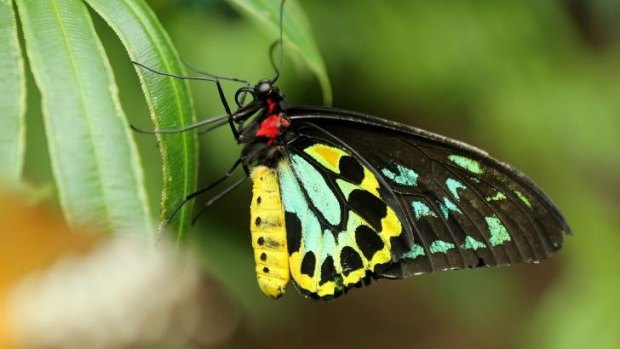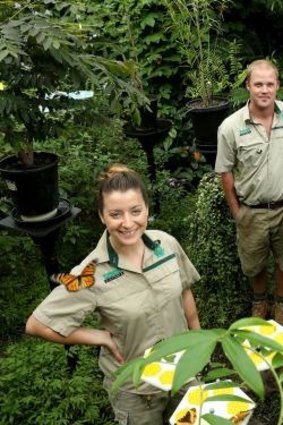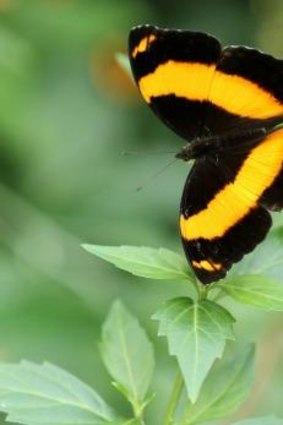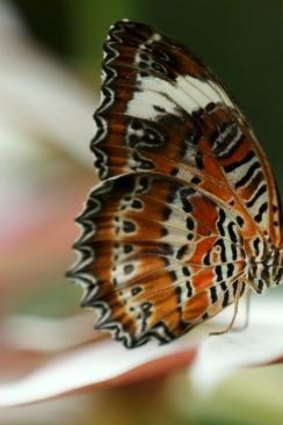This was published 8 years ago
Author of butterfly book laments 'tidy' gardens with little food for insects
By Megan Backhouse
Butterflies as big as birds hover in great clouds of colour and then, as casually as flies, land upon the visitors. Stand in Melbourne Zoo's butterfly house for long enough and you see butterflies also alighting on flowers and – like any good pollinator – zealously imbibing nectar.
Bees might pollinate more plants than any other animal on Earth but butterflies are also dab hands at transferring pollen from flower to flower. And so, in the spirit of last week's World Environment Day, we turn our attention to this pollinating winged insect that has existed for 190 million years and inhabits almost every place on the planet.

A Cairns birdwing butterfly in the butterfly house at the Melbourne Zoo.Credit: Pat Scala
While Singapore has just announced plans to spend $1.4 million doubling the size of a butterfly garden in one of its biggest housing estates, one of the world's leading butterfly experts has warned that, more generally, a "great tragedy . . . comparable to the mass extinction of the dinosaurs" awaits the insect. "Most biologists now believe that within a few decades habitat loss will result in massive losses in butterfly diversity," Adrian Hoskins writes in the recently published Butterflies of the World. Although deforestation is the key culprit in this, Hoskins maintains that gardeners with their "unfortunate compulsion with neatness" are not blame-free.
Australia has about 400 of the world's 17,500 species of butterfly, and the zoo's butterfly house has 15 of them. It also has a voluminous tangle of plants that together provide places for butterflies to feed, rest and lay. With the daytime heating set to at least 28 degrees this slice of the tropics caters to species hailing from Queensland, the Northern Territory and New South Wales.

Invertebrate specialist keeper Kate Pearce and nursery co-ordinator Tom Millane at the Melbourne Zoo.Credit: Pat Scala
At any one time there are between 300 and 500 butterflies here – too many to cater for with growing flowers and so they predominantly feed on artificial nectar. Furthermore, because this is a zoo and not a tropical forest, the exhibits are not left entirely to their own egg-caterpillar-chrysalis-butterfly devices either.
Most butterfly species lay their eggs on the tender young leaves of specific plants, which the emerging caterpillars then eat. But as everyone who has read The Very Hungry Caterpillar knows, caterpillars can eat a lot and so the zoo's nursery co-ordinator, Tom Millane, devotes the bulk of his time to growing them food.
In a vast behind-the-scenes greenhouse he cossets without chemicals (which would be toxic to them) all their select plants, pruning them to encourage the young, soft growth they prefer. These plants are kept in pots so they can be placed in the butterfly house to be laid upon, then removed to another greenhouse for hatching and eating and finally returned to Millane's greenhouse to be revived for another cycle.
For every species of butterfly housed in the zoo's butterfly house, Millane grows hundreds of specimens of their chosen host plant or plants. While the caterpillars of orchard butterflies (Papilio aegeus aegeus) feast on lemon and choysia, those of cruisers (Vindula arsinoe) stick to lacewing vine and red passionflower. Those of the Cairns birdwing (Ornithoptera euphorion), however, only settle for the native Dutchman's pipe. It's not for aesthetics that Millane routinely pollards the breynia 'Iron Range', but to please the caterpillars of the grass yellows (Eurema hecabe).

A lurcher butterfly in the butterfly house at the Melbourne Zoo.Credit: Pat Scala
But none of this has to be the sole preserve of a highly managed greenhouse in the zoo. Just as the zoo's invertebrate specialist keeper, Kate Pearce, says she recently planted her Deer Park garden to encourage butterflies, more of us can garden to please the 24 species of butterfly commonly seen in the Melbourne area on warm days in spring, summer and autumn.
It's about cultivating plants that provide nectar for butterflies (cut-leaf daisy, say, or buddleia) as well as the plants that yield stems, foliage and other food for caterpillars. And it is also about accepting a degree of caterpillar grazing.

A monarch butterfly at Melbourne Zoo.Credit: Pat Scala
"When people see a dingy swallowtail (which is endemic to Australia) on their pride-of-place lemon tree the knee-jerk reaction is to eradicate it but it's unlikely it will damage the tree and you probably have more to gain from seeing it go through its life cycle," Millane says. On the other hand cabbage whites – an introduced European species – are not so gentle in the vegetable patch and do require management.
But just as Hoskins laments our tendency to "tidy up" our landscape, Pearce warns that "architectural gardens with succulents and liriope" don't attract bug life. "In terms of welcoming bugs and butterflies into our gardens, Australians are not quite there yet."
Butterflies of the World, by Adrian Hoskins, published by New Holland, $35
.